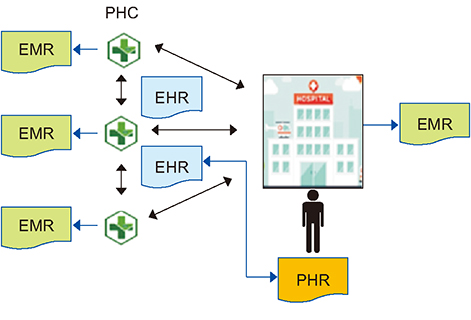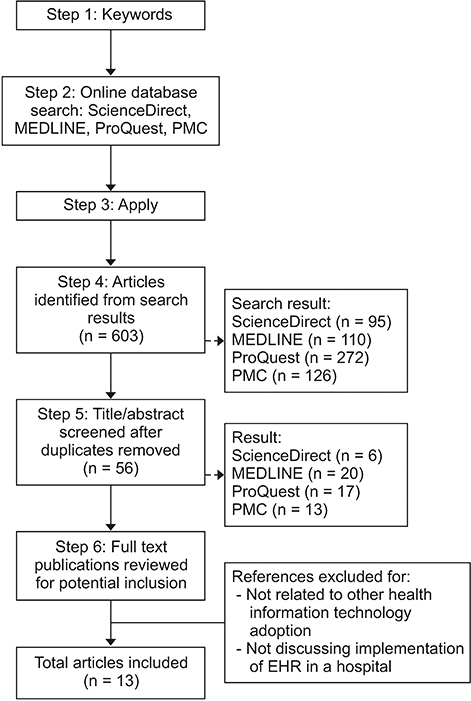Healthc Inform Res.
2019 Jul;25(3):141-152. 10.4258/hir.2019.25.3.141.
Narrative Review for Exploring Barriers to Readiness of Electronic Health Record Implementation in Primary Health Care
- Affiliations
-
- 1Faculty of Public Health, Universitas Indonesia, Jawa Barat, Indonesia. sandra@uinjkt.ac.id
- 2Faculty of Computer Science, Universitas Indonesia, Jawa Barat, Indonesia.
- KMID: 2457466
- DOI: http://doi.org/10.4258/hir.2019.25.3.141
Abstract
OBJECTIVES
The aim of this study is to explore the enabling factors associated with readiness in Electronic Health Record (EHR) implementation and to identify the barriers related to readiness regarding the situation of primary health cares in developed and developing countries.
METHODS
A narrative review of open-source literature was conducted using the ProQuest, ScienceDirect, MEDLINE, and PMC databases to identify the enabling factors and barriers to EHR readiness. The keywords applied were "˜electronic health record', "˜readiness', "˜primary health care', and "˜primary care'.
RESULTS
Some barriers were found that may affect readiness, specifically individual barriers and organizational barriers. In developing countries, organizational barriers such as a lack of skilled manpower, insufficient senior management, and a lack of interaction among team members were the common barriers, while in developed countries individual barriers such as unfamiliarity with new systems and a lack of time to use computers were frequently found as barriers to readiness.
CONCLUSIONS
This study summarized the enabling factors and barriers with regard to EHR readiness in developed and developing countries.
MeSH Terms
Figure
Cited by 1 articles
-
User Acceptance of Electronic Medical Record System: Implementation at Marie Stopes International, Myanmar
Win Min Thit, Sai Wai Yan Myint Thu, Jaranit Kaewkungwal, Ngamphol Soonthornworasiri, Nawanan Theera-Ampornpunt, Boonchai Kijsanayotin, Saranath Lawpoolsri, Sid Naing, Wirichada Pan-ngum
Healthc Inform Res. 2020;26(3):185-192. doi: 10.4258/hir.2020.26.3.185.
Reference
-
1. World Health Organization. Global strategy for health for all by the year 2000. Geneva, Switzerland: World Health Organization;1981.2. Zayyad MA, Toycan M. Factors affecting sustainable adoption of e-health technology in developing countries: an exploratory survey of Nigerian hospitals from the perspective of healthcare professionals. PeerJ. 2018; 6:e4436.
Article3. Doubova SV, Perez-Cuevas R, Ortiz-Panozo E, Hernandez-Prado B. Evaluation of the quality of antenatal care using electronic health record information in family medicine clinics of Mexico City. BMC Pregnancy Childbirth. 2014; 14:168.
Article4. Johnson RJ. A comprehensive review of an electronic health record system soon to assume market ascendancy: EPIC. J Healthc Commun. 2016; 1(4):36.
Article5. World Health Organization. Electronic health records: manual for developing countries. Manila, Philippines: Regional Office for the Western Pacific, World Health Organization;2006.6. McGinn CA, Grenier S, Duplantie J, Shaw N, Sicotte C, Mathieu L, et al. Comparison of user groups' perspectives of barriers and facilitators to implementing electronic health records: a systematic review. BMC Med. 2011; 9:46.
Article7. Biruk S, Yilma T, Andualem M, Tilahun B. Health professionals' readiness to implement electronic medical record system at three hospitals in Ethiopia: a cross sectional study. BMC Med Inform Decis Mak. 2014; 14:115.
Article8. Li J, Land LP, Chattopadhyaya S. E-Health readiness framework from Electronic Health Records perspective. Int J Internet Enterp Manag. 2010; 6(4):035626.
Article9. Cherry B, Owen D, Bachetti B. Determining factors of organizational readiness for technology adoption in long-term care facilities. Lubbock (TX): The Garrison Institute on Aging, Texas Tech University Health Science Center;2006.10. Fritz F, Tilahun B, Dugas M. Success criteria for electronic medical record implementations in low-resource settings: a systematic review. J Am Med Inform Assoc. 2015; 22(2):479–488.
Article11. United Nations. Country classification: data sources, country classifications and aggregation methodology. United Nations. World economic situation and prospects 2014. New York (NY): United Nations;2014. p. 143–150.12. World Health Organization. Medical records manual: a guide for developing countries. Manila, Philippines: World Health Organization;2006.13. Goldfarb NI. Assessing quality of primary care through medical record review: lessons and opportunities. Health Policy Newsl. 2000; 13(2):8.14. Rodrigues J, Compte SS, De la Torre Diez I. E-Health systems: theory, advances and technical applications. London: ISTE Press;2016.15. Heart T, Ben-Assuli O, Shabtai I. A review of PHR, EMR and EHR integration: a more personalized healthcare and public health policy. Health Policy Technol. 2017; 6(1):20–25.
Article16. World Health Organization. Primary health care: now more than ever. Geneva, Switzerland: World Health Organization;2008.17. Mater W, Aldwairi M, Ibrahim R. Enhanced teamwork communication model for electronic clinical pathways in healthcare. Open Bioinform J. 2018; 11:140–163.
Article18. Henricks WH. “Meaningful use” of electronic health records and its relevance to laboratories and pathologists. J Pathol Inform. 2011; 2:7.
Article19. Evans RS. Electronic health records: then, now, and in the future. Yearb Med Inform. 2016; Suppl 1. S48–S61.
Article20. Ferrari R. Writing narrative style literature reviews. Med Writ. 2015; 24(4):230–235.
Article21. Afrizal S, Hakiem N, Sensuse DI. Analysis of the readiness of e-Government implementation at the ministerial level of the Republic of Indonesia. In : Proceedings of the International Conference on Business and Management Research (ICBMR 2017); 2017 Aug 15-16; Jakarta, Indonesia.22. Timmings C, Khan S, Moore JE, Marquez C, Pyka K, Straus SE. Ready, set, change! Development and usability testing of an online readiness for change decision support tool for healthcare organizations. BMC Med Inform Decis Mak. 2016; 16:24.
Article23. Ajami S, Ketabi S, Isfahani SS, Heidari A. Readiness assessment of electronic health records implementation. Acta Inform Med. 2011; 19(4):224–227.
Article24. Lambooij MS, Drewes HW, Koster F. Use of electronic medical records and quality of patient data: different reaction patterns of doctors and nurses to the hospital organization. BMC Med Inform Decis Mak. 2017; 17(1):17.
Article25. Abdulrahman MD, Subramanian N. Barriers in implementing reverse logistics in Chinese manufacturing sectors: an empirical analysis. In : Proceedings of the POMS 23rd Annual Conference; 2011 Apr 20-23; Chicago, IL.26. Mannan R, Murphy J, Jones M. Is primary care ready to embrace e-health? A qualitative study of staff in a London primary care trust. Inform Prim Care. 2006; 14(2):121–131.
Article27. Shea CM, Reiter KL, Weaver MA, McIntyre M, Mose J, Thornhill J, et al. Stage 1 of the meaningful use incentive program for electronic health records: a study of readiness for change in ambulatory practice settings in one integrated delivery system. BMC Med Inform Decis Mak. 2014; 14:119.
Article28. Pandhi N, Yang WL, Karp Z, Young A, Beasley JW, Kraft S, Carayon P. Approaches and challenges to optimising primary care teams' electronic health record usage. Inform Prim Care. 2014; 21(3):142–151.
Article29. Mason P, Mayer R, Chien WW, Monestime JP. Overcoming barriers to implementing electronic health records in rural primary care clinics. Qual Rep. 2017; 22(11):2943–2955.
Article30. Saleh S, Khodor R, Alameddine M, Baroud M. Readiness of healthcare providers for eHealth: the case from primary healthcare centers in Lebanon. BMC Health Serv Res. 2016; 16(1):644.
Article31. Shin P, Sharac J. Readiness for meaningful use of health information technology and patient centered medical home recognition survey results. Medicare Medicaid Res Rev. 2013; 3(4):mmrr.003.04.b01.
Article32. Melas CD, Zampetakis LA, Dimopoulou A, Moustakis VS. An empirical investigation of technology readiness among medical staff based in Greek hospitals. Eur J Inf Syst. 2014; 23(6):672–690.
Article33. Fuji KT, Galt KA, Serocca AB. Personal health record use by patients as perceived by ambulatory care physicians in Nebraska and South Dakota: a cross-sectional study. Perspect Health Inf Manag. 2008; 5:15.34. Vydra TP, Cuaresma E, Kretovics M, Bose-Brill S. Diffusion and use of tethered personal health records in primary care. Perspect Health Inf Manag. 2015; 12:1c.35. Ayatollahi H, Mirani N, Haghani H. Electronic health records: what are the most important barriers? Perspect Health Inf Manag. 2014; 11:1c.36. Papoutsi C, Reed JE, Marston C, Lewis R, Majeed A, Bell D. Patient and public views about the security and privacy of Electronic Health Records (EHRs) in the UK: results from a mixed methods study. BMC Med Inform Decis Mak. 2015; 15:86.
Article37. Darko-Yawson S, Ellingsen G. Assessing and improving EHRs data quality through a socio-technical approach. Procedia Comput Sci. 2016; 98:243–250.
Article38. Terry AL, Thorpe CF, Giles G, Brown JB, Harris SB, Reid GJ, Stewart M, et al. Implementing electronic health records: Key factors in primary care. Can Fam Physician. 2008; 54(5):730–736.39. Safdari R, Ghazisaeidi M, Jebraeily M. Electronic health records: critical success factors in implementation. Acta Inform Med. 2015; 23(2):102–104.
Article40. Kuo KM, Liu CF, Ma CC. An investigation of the effect of nurses' technology readiness on the acceptance of mobile electronic medical record systems. BMC Med Inform Decis Mak. 2013; 13:88.
Article41. Weiner BJ. A theory of organizational readiness for change. Implement Sci. 2009; 4:67.
Article42. Sulmasy LS, Lopez AM, Horwitch CA. American College of Physicians Ethics, Professionalism and Human Rights Committee. Ethical implications of the electronic health record: in the service of the patient. J Gen Intern Med. 2017; 32(8):935–939.
Article
- Full Text Links
- Actions
-
Cited
- CITED
-
- Close
- Share
- Similar articles
-
- Barriers in Health Information Systems and Technologies to Support Maternal and Neonatal Referrals at Primary Health Centers
- Satisfaction with Paper-Based Dental Records and Perception of Electronic Dental Records among Dental Professionals in Myanmar
- Needs Assessment for Functionalities in Electronic Health Record Systems in General Hospitals
- Korean and United States: Comparison of Costs of Nursing Interventions
- Clinical Terminologies: A Solution for Semantic Interoperability





